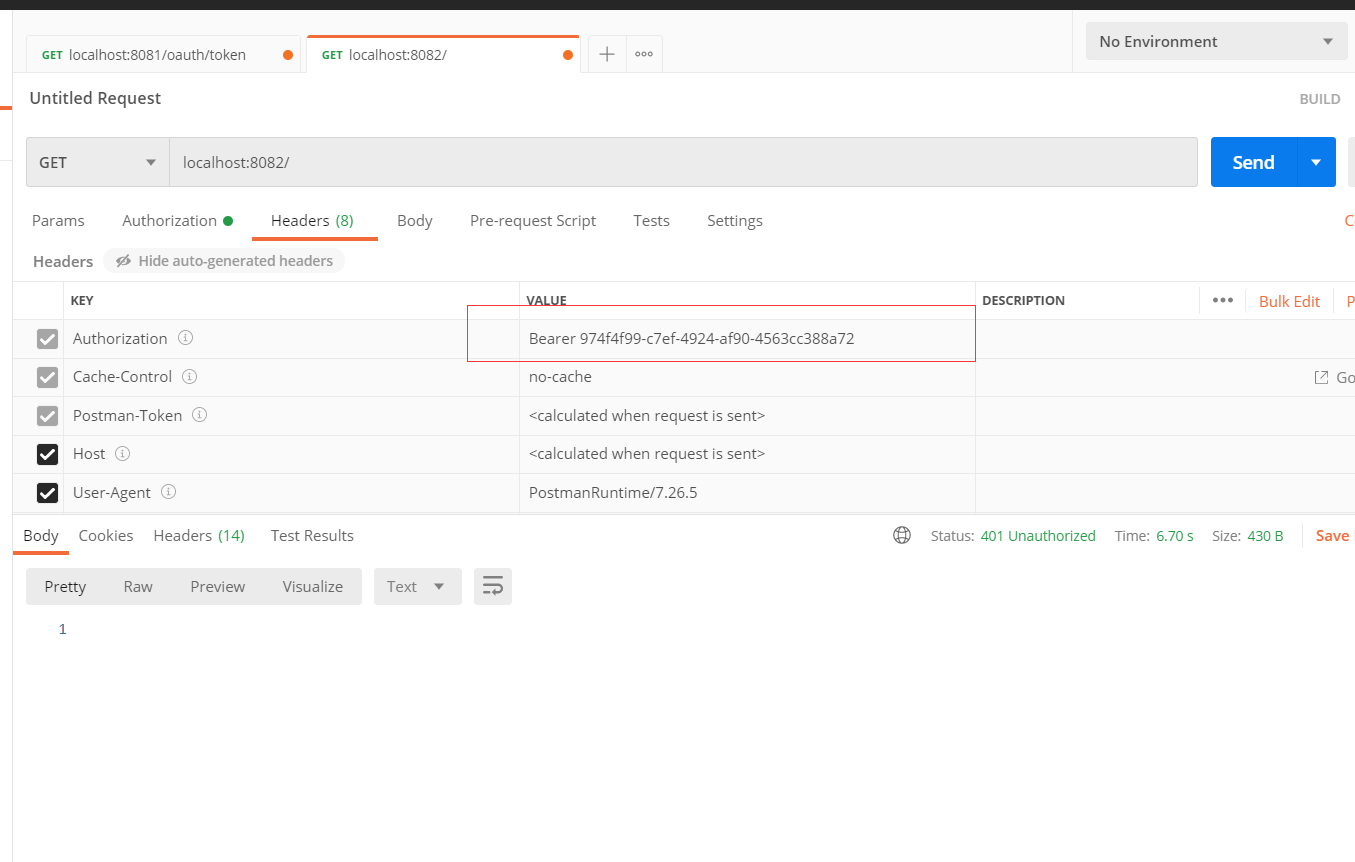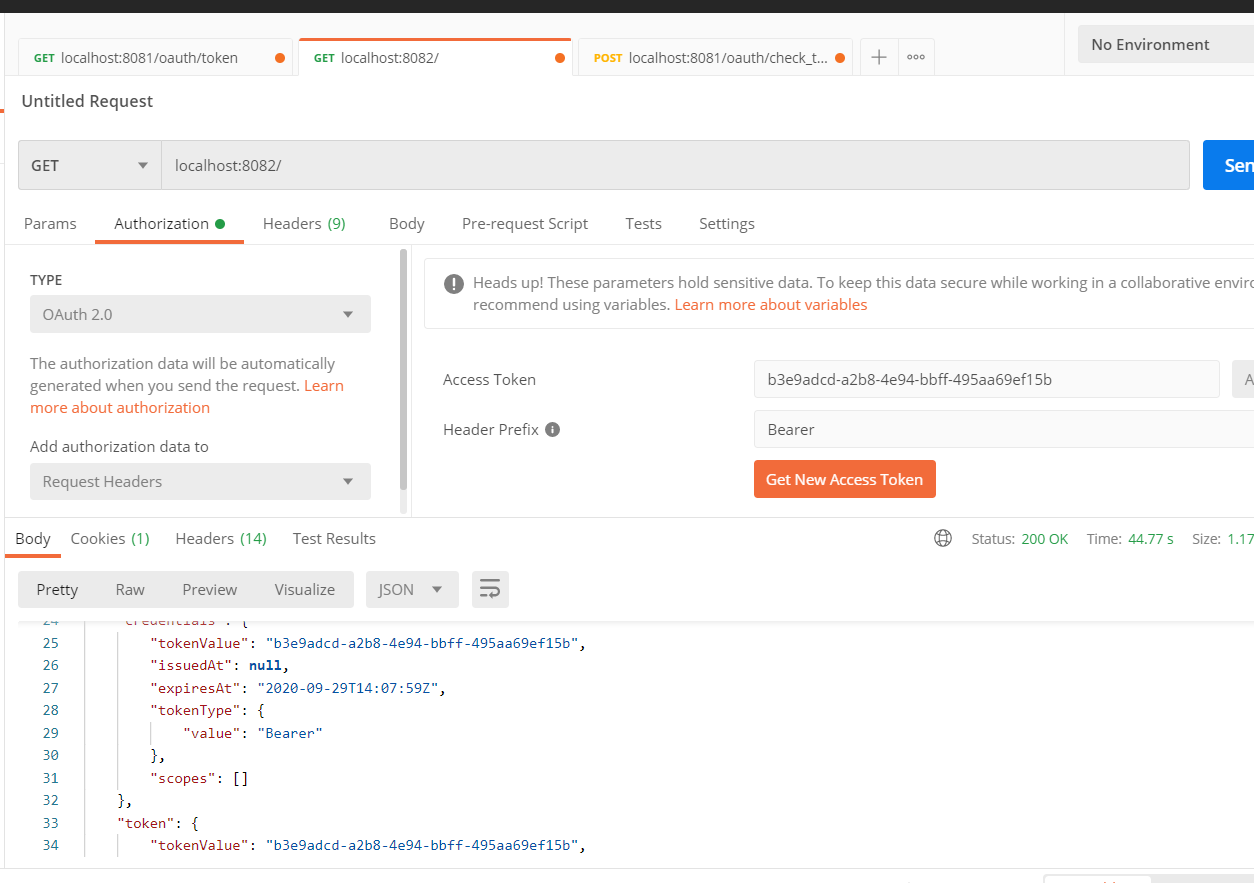本项目采用spring-boot的方式:spring-boot版本为:2.3.3.RELEASE
本文主要是想提供一个401解决思路
源码地址: security5-resource
博客地址: https://blog.hb0730.com/archives/springsecurity5之resourceserver资源服务器
authorizationServer 认证服务器
pom 依赖
<dependencies>
<dependency>
<groupId>org.springframework.boot</groupId>
<artifactId>spring-boot-starter-security</artifactId>
</dependency>
<dependency>
<groupId>org.springframework.boot</groupId>
<artifactId>spring-boot-starter-web</artifactId>
</dependency>
<dependency>
<groupId>org.springframework.security.oauth</groupId>
<artifactId>spring-security-oauth2</artifactId>
<version>2.3.3.RELEASE</version>
</dependency>
<dependency>
<groupId>org.springframework.security</groupId>
<artifactId>spring-security-test</artifactId>
</dependency>
<dependency>
<groupId>org.springframework.boot</groupId>
<artifactId>spring-boot-starter-test</artifactId>
</dependency>
<dependency>
<groupId>org.projectlombok</groupId>
<artifactId>lombok</artifactId>
</dependency>
</dependencies>
configuration 配置
authorization Server授权服务器
/**
* 授权服务器配置
*
* @author bing_huang
*/
@Configuration
@EnableAuthorizationServer
@RequiredArgsConstructor
public class AuthorizationServerConfiguration extends AuthorizationServerConfigurerAdapter {
private final PasswordEncoder passwordEncoder;
private final UserDetailsService userDetailsService;
/**
* 来支持 password grant type
*/
private final AuthenticationManager authenticationManager;
@Override
public void configure(AuthorizationServerSecurityConfigurer security) throws Exception {
// 允许客户端认证ClientCredentialsTokenEndpointFilter
security.allowFormAuthenticationForClients()
.checkTokenAccess("permitAll()")
.tokenKeyAccess("permitAll()");
}
@Override
public void configure(ClientDetailsServiceConfigurer clients) throws Exception {
// 内存模式
clients.inMemory()
//客户端id
.withClient("client")
// 客户端secret
.secret(passwordEncoder.encode("secret"))
//范围
.scopes("all")
//权限
.authorities("read", "writer")
//授权类型
.authorizedGrantTypes("password", "refresh_token");
}
@Override
public void configure(AuthorizationServerEndpointsConfigurer endpoints) throws Exception {
// 允许get,post请求token端点
endpoints.allowedTokenEndpointRequestMethods(HttpMethod.POST, HttpMethod.GET)
// token 存储服务
.tokenServices(defaultTokenServices())
//user 服务
.userDetailsService(userDetailsService)
//password grant type
.authenticationManager(authenticationManager);
}
/**
* <p>注意,自定义TokenServices的时候,需要设置@Primary,否则报错,</p>
* 自定义的token
* 认证的token是存到redis里的
*
* @return DefaultTokenServices
*/
@Primary
@Bean
public DefaultTokenServices defaultTokenServices() {
DefaultTokenServices tokenServices = new DefaultTokenServices();
tokenServices.setTokenStore(tokenStore());
tokenServices.setSupportRefreshToken(true);
return tokenServices;
}
/**
* redis存储令牌
*
* @return token存储
*/
@Bean
public TokenStore tokenStore() {
return new InMemoryTokenStore();
}
}
web Security配置
/**
* web Security
*
* @author bing_huang
*/
@EnableWebSecurity
@Configuration
@RequiredArgsConstructor
public class WebSecurityConfiguration extends WebSecurityConfigurerAdapter {
@Override
protected void configure(AuthenticationManagerBuilder auth) throws Exception {
auth.userDetailsService(this.userDetailsService())
.passwordEncoder(passwordEncoder());
}
@Override
protected void configure(HttpSecurity http) throws Exception {
http
//禁用csrf
.csrf().disable()
//禁用session
.sessionManagement()
.sessionCreationPolicy(SessionCreationPolicy.STATELESS)
.and()
.authorizeRequests()
//放开端口
.antMatchers("/oauth/**", "/actuator/**").permitAll()
//其余拦截
.anyRequest().authenticated()
.and()
// 允许basic认证
.httpBasic()
;
}
@Override
@Bean
protected UserDetailsService userDetailsService() {
InMemoryUserDetailsManager userDetailsManager = new InMemoryUserDetailsManager();
userDetailsManager.createUser(
User.withUsername("user")
.password(passwordEncoder().encode("123456"))
.authorities("ROLE_USEr").build());
return userDetailsManager;
}
@Bean
public PasswordEncoder passwordEncoder() {
return new BCryptPasswordEncoder();
}
@Override
@Bean
public AuthenticationManager authenticationManagerBean() throws Exception {
return super.authenticationManagerBean();
}
}
resource Server资源服务器
这里的资源服务器采用security5方式使用内省方式具体可以看官方demo:oauth2resourceserver-opaque
pom
<dependencies>
<dependency>
<groupId>org.springframework.boot</groupId>
<artifactId>spring-boot-starter-security</artifactId>
</dependency>
<dependency>
<groupId>org.springframework.boot</groupId>
<artifactId>spring-boot-starter-web</artifactId>
</dependency>
<dependency>
<groupId>org.springframework.security</groupId>
<artifactId>spring-security-oauth2-resource-server</artifactId>
</dependency>
<dependency>
<groupId>org.springframework.security</groupId>
<artifactId>spring-security-test</artifactId>
</dependency>
<dependency>
<groupId>org.springframework.boot</groupId>
<artifactId>spring-boot-starter-test</artifactId>
</dependency>
<dependency>
<groupId>org.projectlombok</groupId>
<artifactId>lombok</artifactId>
</dependency>
<dependency>
<groupId>com.nimbusds</groupId>
<artifactId>oauth2-oidc-sdk</artifactId>
</dependency>
</dependencies>
configuration 配置
/**
* 资源服务器
*
* @author bing_huang
*/
@EnableWebSecurity
@Configuration
@RequiredArgsConstructor
public class WebSecurityServerConfiguration extends WebSecurityConfigurerAdapter {
private final OAuth2ResourceServerProperties properties;
@Override
protected void configure(HttpSecurity http) throws Exception {
http
.authorizeRequests()
.anyRequest().authenticated()
.and()
.csrf().disable()
.cors();
http.oauth2ResourceServer()
.opaqueToken()
.introspectionClientCredentials(
properties.getOpaquetoken().getClientId(),
properties.getOpaquetoken().getClientSecret())
.introspectionUri(properties.getOpaquetoken().getIntrospectionUri());
}
@Bean
public PasswordEncoder passwordEncoder() {
return new BCryptPasswordEncoder();
}
}
yaml配置
server:
port: 8082
spring:
security:
oauth2:
resourceserver:
opaquetoken:
client-id: client
client-secret: secret
introspection-uri: http://localhost:8081/introspect
所以我们在认证服务器添加introspect端点
introspect 内省端点
/**
* @author bing_huang
*/
@FrameworkEndpoint
@RequiredArgsConstructor
public class IntrospectEndpoint {
private final TokenStore tokenStore;
@PostMapping("/introspect")
@ResponseBody
public Map<String, Object> introspect(@RequestParam("token") String token) {
OAuth2AccessToken accessToken = this.tokenStore.readAccessToken(token);
Map<String, Object> attributes = new HashMap<>();
if (accessToken == null || accessToken.isExpired()) {
attributes.put("active", false);
return attributes;
}
OAuth2Authentication authentication = this.tokenStore.readAuthentication(token);
attributes.put("active", true);
attributes.put("exp", accessToken.getExpiration().getTime());
attributes.put("scope", accessToken.getScope().stream().collect(Collectors.joining(" ")));
attributes.put("sub", authentication.getName());
return attributes;
}
}
访问
1. 获取access_token
注意这里采用的是自定义端点来获取access_token
-
认证服务器自定义端点
/** * 自定义Oauth2自定义返回格式(json) * * @author bing_huang */ @RestController @RequestMapping("/oauth") @RequiredArgsConstructor public class OauthController { private final TokenEndpoint tokenEndpoint; private final TokenStore tokenStore; /** * get登录 */ @GetMapping("/token") public LinkedHashMap<String, Object> getAccessToken(Principal principal, @RequestParam Map<String, String> parameters) throws HttpRequestMethodNotSupportedException { return custom(tokenEndpoint.getAccessToken(principal, parameters).getBody()); } /** * post登录 */ @PostMapping("/token") public LinkedHashMap<String, Object> postAccessToken(Principal principal, @RequestParam Map<String, String> parameters) throws HttpRequestMethodNotSupportedException { return custom(tokenEndpoint.postAccessToken(principal, parameters).getBody()); } private LinkedHashMap<String, Object> custom(OAuth2AccessToken accessToken) { DefaultOAuth2AccessToken token = (DefaultOAuth2AccessToken) accessToken; LinkedHashMap<String, Object> data = new LinkedHashMap<>(token.getAdditionalInformation()); data.put("accessToken", token.getValue()); if (token.getRefreshToken() != null) { data.put("refreshToken", token.getRefreshToken()); } return data; } }
2. 通过access_token访问资源服务器
请求头必须带有Authorization:Bearer 974f4f99-c7ef-4924-af90-4563cc388a72

发现没有任何的错误信息: 修改日志级别
logging:
level:
org:
springframework:
security: DEBUG
在此请求方法日志会有报错信息为401

为何我们用access_token去访问资源服务会报401无权限呢
401 无权限访问解决
1. 内省opaqueToken是如何访问的??
查看spring官网oauth2resourceserver-opaque-architecture 内省模式的工作方式
当一个请求发生:BearerTokenAuthenticationFilter将认证信息BearerTokenAuthenticationToken传递给AuthenticationManager,由ProviderManager找到具体的OpaqueTokenAuthenticationProvider,而OpaqueTokenAuthenticationProvider通过OpaqueTokenIntrospector换取认证信息
查看OpaqueTokenIntrospector只有一个NimbusOpaqueTokenIntrospector的实现,其内部通过RestTemplate请求认证服务器

而NimbusOpaqueTokenIntrospector的请求信息则是: 请求头是basic认证的客户端信息,参数则是token
这样一来我们就能确认认证服务filter存在问题
2. 认证服务器的filter 顺序
在认证服务器配置AuthorizationServerConfiguration中我们已经放开的客户端认证security.allowFormAuthenticationForClients(),client认证所对应的filter又是什么
在阅读源码源码得知为ClientCredentialsTokenEndpointFilter
源码
org.springframework.security.oauth2.config.annotation.web.configurers.AuthorizationServerSecurityConfigurer
@Override
public void configure(HttpSecurity http) throws Exception {
// ensure this is initialized
frameworkEndpointHandlerMapping();
if (allowFormAuthenticationForClients) {
clientCredentialsTokenEndpointFilter(http);
}
for (Filter filter : tokenEndpointAuthenticationFilters) {
http.addFilterBefore(filter, BasicAuthenticationFilter.class);
}
http.exceptionHandling().accessDeniedHandler(accessDeniedHandler);
}
private ClientCredentialsTokenEndpointFilter clientCredentialsTokenEndpointFilter(HttpSecurity http) {
ClientCredentialsTokenEndpointFilter clientCredentialsTokenEndpointFilter = new ClientCredentialsTokenEndpointFilter(
frameworkEndpointHandlerMapping().getServletPath("/oauth/token"));
clientCredentialsTokenEndpointFilter
.setAuthenticationManager(http.getSharedObject(AuthenticationManager.class));
OAuth2AuthenticationEntryPoint authenticationEntryPoint = new OAuth2AuthenticationEntryPoint();
authenticationEntryPoint.setTypeName("Form");
authenticationEntryPoint.setRealmName(realm);
clientCredentialsTokenEndpointFilter.setAuthenticationEntryPoint(authenticationEntryPoint);
clientCredentialsTokenEndpointFilter = postProcess(clientCredentialsTokenEndpointFilter);
http.addFilterBefore(clientCredentialsTokenEndpointFilter, BasicAuthenticationFilter.class);
return clientCredentialsTokenEndpointFilter;
}
当我们再次请求并且debug在FilterChainProxy.doFilterInternal查看filters是顺序以及个数和是否存在ClientCredentialsTokenEndpointFilter

发现并没有clientCredentialsTokenEndpointFilter
消失的clientCredentialsTokenEndpointFilter
在FilterChainProxy.getFilters中我们发现filterChains有两个

而满足我们的其中的一个,如何确定url呢,在spring oauth2当中提供了获取token的一个远程调用类RemoteTokenServices

和我们的请求类似:其认证端点也是一个可配置化的一般为/oauth/check_token
所以我们将资源服务器的yaml请求改为/oauth/check_token*后再一次请求


filter的生成
FilterChainProxyfilterChain代理每一个请求都会经过,这里也存储了每一个filter
filterChainProxy的生成:
FilterChainProxy的生成是通过WebSecurity#performBuild() new

在#performBuild方法中还存在一个默认DefaultSecurityFilterChain这个就是WebSecurity配置了ignoredRequests
而另一个是是一个集合FilterChain>> securityFilterChainBuilders = new ArrayList<SecurityBuilder<? extends SecurityFilterChain>>()
securityFilterChainBuilders的生成是通过add添加进入的,也就是通过WebSecurity#addSecurityFilterChainBuilder添加进入.所以当一个应用有几个webSecurity应该就有几个SecurityFilterChain

SecurityBuilder
结构:

如何找到具体的实现的类呢:
我们通过securityFilterChainBuilders往上查找

可以得知他的实现类则是HttpSecurity,所以我们一步步的build进入HttpSecurity



进入httpSecurity类

@Override
protected DefaultSecurityFilterChain performBuild() {
filters.sort(comparator);
return new DefaultSecurityFilterChain(requestMatcher, filters);
}
就可以查看有哪些filter添加


